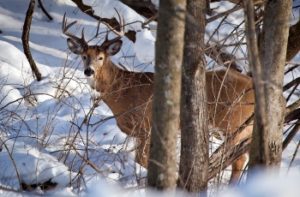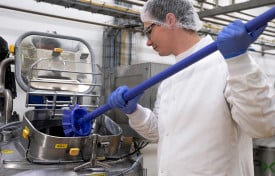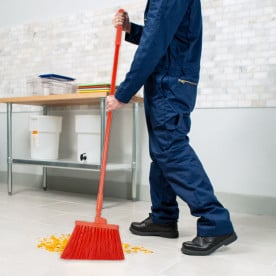For many people throughout the United States, hunting wild game is a beloved pastime--whether for the enjoyment of the outdoors, thrill of the hunt, or an economical way to obtain food. Along with this hobby comes many safety precautions. Just as a hunter should be trained in firearm safety and first aid procedures, food safety is also important. Educating one’s self on the dangers of foodborne illness is one step closer to harvesting a game animal for safe consumption.
Know The Risks
Harmful bacteria such as Salmonella and E.coli can live in raw or undercooked game meats. It is important to note the stages in which contamination may occur, and what steps can be taken to ensure you have processed your animal in the safest means possible.
Contamination can occur through the initial wound sustained by a bullet or an arrow. It is best to avoid hitting or puncturing the area around the stomach and intestines, as this would result in spoiling much of the surrounding meat due to the bacteria that lives within these organs.
 Another area of concern in game food contamination is the possibility of cross-contamination. Be sure to pack clean utensils and tools for field dressing or butchering your game animal. Even the smallest of pathogens can wreak havoc on the quality of your game meat. Pack alcohol wipes for regular cleaning of the hands and tools before, during, and after use. Also plan to pack supplies such as paper towels, a clean plastic drop cloth or tarp, and disposable plastic gloves. Keeping your area, tools, and hands clean during the removal of entrails is a big part of ensuring your kill will be safely preserved until you can reach a controlled environment for processing.
Another area of concern in game food contamination is the possibility of cross-contamination. Be sure to pack clean utensils and tools for field dressing or butchering your game animal. Even the smallest of pathogens can wreak havoc on the quality of your game meat. Pack alcohol wipes for regular cleaning of the hands and tools before, during, and after use. Also plan to pack supplies such as paper towels, a clean plastic drop cloth or tarp, and disposable plastic gloves. Keeping your area, tools, and hands clean during the removal of entrails is a big part of ensuring your kill will be safely preserved until you can reach a controlled environment for processing.
____________________________________________________
Recommended Equipment for Field Dressing Deer & Other Large Game
For proper field dressing, bring the following items with you when you hunt:
- Sharp knife
- Small hatchet
- Whetstone or steel for sharpening
- Several feet of rope or nylon cord
- Rubber bands
- Clean cloths or paper towels
- Resealable plastic storage bags
- A large cooler full of ice/snow
- Ground pepper and cheesecloth
- Disposable plastic gloves
- Clean drinking water
Recommended Equipment for Field Dressing Game Birds
For proper field dressing of game birds, bring the following items with you when you hunt:
- Sharp knife
- Resealable plastic storage bags
- Whetstone or steel for sharpening
- Cooler full of ice/snow
- Rope or nylon cord
- Disposable plastic gloves
- Clean cloths or paper towels
- Clean drinking water
____________________________________________________
Preserving Your Game Meat for Processing
Temperature control is a factor that is mostly out of the control of the hunter. Depending on the region you live, hunting season climate can range from warm and humid to below freezing temperatures. In areas like Wisconsin, we often don’t have to worry about this aspect, as our harvested game cools down quickly and for the most part remains on snow-covered ground until it can be loaded for transport. If this is not the case, consider taking coolers filled with ice or packaged dry ice. If the outside temperature is above 41° F, the hide should be removed from large game as quickly as possible. The longer the carcass remains in temperatures above 41°F, the greater the risk of foodborne pathogen growth. When transporting your large game animal, do not wrap the carcass. Trapping heat around the carcass encourages the growth of bacteria and other foodborne pathogens. In contrast, with small game animals like rabbits and squirrels, it is recommended to skin the animal while field dressing, wrap the carcass in clean plastic wrap or butcher paper, and place in a cooler for transport. The smaller the game, the quicker the internal temperature will cool down – improving the overall safety of the meat.
Game meat should then be processed and packaged as quickly as possible, either by utilizing a commercial processing facility or implementing the same practices as during field dressing by processing on a clean surface with clean tools and protective coverings for your hands and other surfaces.
Be Informed Of Other Factors
One last thing to consider when preparing for your hunt is being educated on the signs of Chronic Wasting Disease (CWD). This prion disease affects deer populations across North America, including elk, reindeer, sika deer, and moose. The Centers for Disease Control and Prevention advise that hunters try to minimize their risk for exposure by consulting with their area DNR or wildlife agencies as to areas of known cases and where testing sites are located in your hunting vicinity. Always avoid eating meat from an animal that seems sick or tests positive for CWD.
Click here for more information on how to field dress an animal and food safety tips.
Sourced from Food Safety News.







